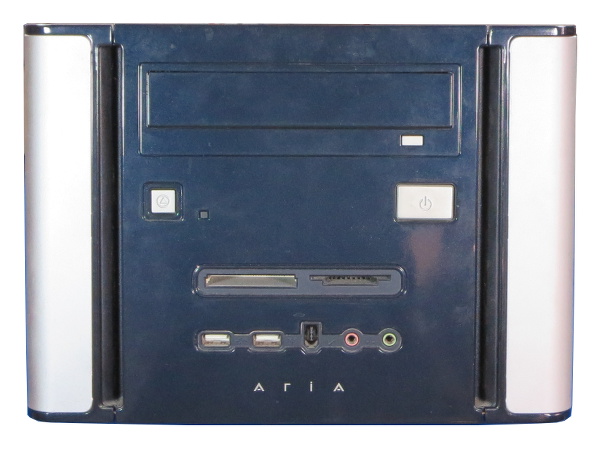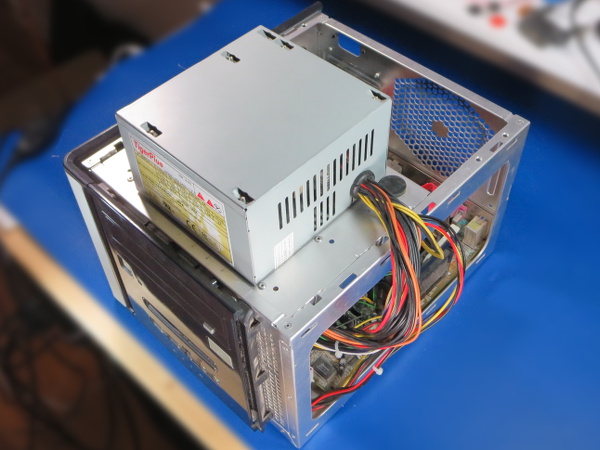Antec Aria AR300 PSU Repair
Have you ever bought a computer case with a proprietary PSU form factor? What do you do when it eventually wears out? One option is to repair it.
The Antec Aria
When I decided to build my Northwood-based PC back in 2004, I went for style and relative portability instead of ease of building, maintenance or cooling. While I was happy with the visual results, small footprint and portability, the same could not be said about how the processor heat sink's proximity to the side wall and the power supply's enclosure hanging right over it were causing the CPU fan to screech along at 3800 RPM after just a few minutes. This effectively forced me to permanently remove the side panel in order to make the fan noise bearable. The AR300 could have really used a lot more intake mesh area to help move air through the case, and especially out of the CPU area. Airflow inadequacy aside, everything else was fine until about a year ago.
What happened? I wanted to scan some documents. However, my scanner wasn't supported under Windows 8.1 running on a Core i5. So, I decided to boot the old Pentium 4-based box still running XP and get the job done that way. I pushed the power button and waited a few seconds. No noise, no lights, no fans. I checked the connections inside and out, and verified that the outlet I plugged into had power. Then, I unplugged the ATX connector and tried the “paperclip test”. Still nothing. Finally, I connected my digital multimeter to the 5VSB line and read 5.5V, confirming that the power supply was definitely receiving power and that something suspicious must be going on with the 5VSB output.
At this point, you might be thinking the situation sounds similar to the SL300 from a few months ago, and you would be correct. My first definitive proof that something had gone wrong with the SL300 was also increased output voltage on the 5VSB rail. Chronologically though, the AR300 failed a few months earlier. I chose to try repairing the SL300 first mainly because the SL300 could still be coerced into fully powering up, while the AR300's main outputs were completely unresponsive.
What do you do when your proprietary form factor power supply blows up? Either buy a refurbished or used replacement (if you can find a reasonably priced one from a trustworthy source), have it repaired, repair it yourself, rig it to a regular ATX PSU or ditch the proprietary case it came with. I did not feel like shoehorning my old P4 into a new case just to scan some paper, and still lacked the equipment to properly investigate at the time. I ended up rigging it by scavenging an old TigerPlus supply from a friend's PC that had been collecting dust for over a year. I put it on top of the Aria with its top and side panels off, plugged it in and called it done until further notice. The result wasn't pretty, safe or particularly reliable, but it got my scans done.
Since my first power supply repair story was such a success and some of you were curious about what went wrong with the AR300, I decided to investigate and hopefully restore my Aria to its former glory by fixing its proprietary form factor ATX power supply.
Before we get started, let's get the boring stuff out of the way.
A Foreword
I do not normally bother repairing power supplies beyond re-capping the outputs. This is only my second repair job that's more in-depth. You may want to read about my SL300 PSU repair if you have not done so already, since there will be many similarities and references to it.
Get Tom's Hardware's best news and in-depth reviews, straight to your inbox.
Disclaimer
As usual when fiddling inside line-powered equipment (and especially on the primary side of it), don't try this at home unless you are a trained professional or have equivalent experience. You assume all risks for whatever it is you decide to do.
-
iam2thecrowe That was a good read. I have a lot of custom power supplies (not PC atx) that i would like to fix at work instead of replace, would be a lot cheaper (there's some high wattage power supplies that cost $5000 to replace). Need to convince the boss to buy a good oscilloscope.Reply -
Rookie_MIB I have several of those cases - they make nice little machines for office use but the PSUs tend to flake. I've had to replace several...Reply -
Daniel Sauvageau All the standby power supplies I remember looking at are of the good old flyback design and one particularity of the flyback topology is that it has the worst ripple current on the output capacitors of all converter topologies or in other words: it is the harshest on output capacitors. Until I saw the waveforms while poking around the SL300, one little yet important detail skipped my mind: the harsh current waveform behavior applies to ALL outputs.Reply
Any flyback supply with sub-par output capacitors on any of its outputs will inevitably fail in relatively short order.
After that 'oops' moment, I decided to pop the lid on my LG 204WT which I thought had dying CCFL tubes, popped three of its auxiliary supply capacitors off the board, measured them at 5-20 ohms of ESR, replaced them, no more flicker or random turn-on issues. -
gnyff I love it when stuff is repaired! It's so sad that almost every consumer device today is made to fail and be replaced. Even in the cases where the designer did not specifically design for failure most commonly it's definitely not cost-effective for the user to have it repaired. :-(Reply
Anyways, I've also replaced one of those lousy non-standard PSU. Hard to find and depressingly expensive. Thus, I am avoiding non-standard parts as much as possible now! ;-)
By the way, in one of my systems the standby power was around 12W (!) even after shutting off 5VSB functions (wake on LAN, keyboard etc) in the BIOS. I did on bother to investigate further (thinking "lousy supply"!) and simply added a proper "full off" power switch. Probably other owners should think of doing the same ;-) -
Rookie_MIB Reply16509494 said:Anyways, I've also replaced one of those lousy non-standard PSU. Hard to find and depressingly expensive. Thus, I am avoiding non-standard parts as much as possible now! ;-)
By the way, in one of my systems the standby power was around 12W (!) even after shutting off 5VSB functions (wake on LAN, keyboard etc) in the BIOS. I did on bother to investigate further (thinking "lousy supply"!) and simply added a proper "full off" power switch. Probably other owners should think of doing the same ;-)
I wonder if a SFX PSU could be mounted in those cases. Might be a viable solution... -
nukemaster Another great one!Reply
I actually was interested in that case back when it was released, but just kept rocking the Sonata and Sonata II. While my power supplies did not fail. caps leaked after a while(power supplies still worked)and I took the power supplies out of service forever.
Rookie_MIB,
SFX would be an interesting idea to see for sure. My SFX is still going after 5 years of 24/7 operation(not bad for a case included 300 watt unit). -
Daniel Sauvageau Reply
The dimensions might fit but mounting holes would be on the wrong side (for mounting in a way that might fit internally) and the IEC socket would face either the motherboard or the top cover. Nothing some drill-and-tapping with some wire splicing cannot fix for people who would favor this route instead of a repair of the existing unit where that is possible.16509868 said:I wonder if a SFX PSU could be mounted in those cases. Might be a viable solution...
BTW, the total repair cost for the 5VSB side is about $1.50 for the caps and resistor. The rest is basically free since I scavenged the SCs from a dead (catastrophic primary-side failure) PSU and would have cost around $2.50 otherwise. If Asus had specified higher quality parts from Channel Well though, the PSU may have cost less than $0.50 extra to get right on the first try. Evem doing as little as specifying Teapo SC as the minimum requirement would have easily doubled the trouble-free service life over using SEK..
It always bugs me when only a few pennies worth in parts and materials can spell the difference between a product that might only last 2-3 years and a product that should easily last 10+ years. -
nukemaster That small cost per unit adds up.Reply
I can not count the number of times I say, gee a xx cent part would have solved this damn issue and yet no one does it.
Drilling and making it fit is no issue. :)
I still get my small system fix with an SG05 case.
Where do you get your parts from? Digikey is not too expensive, but many times the shipping cost more than the parts(especially with resistors that are cheap to begin with.). -
Daniel Sauvageau Reply
The "small cost" may add up but if you charge $1 to put the $0.50 worth of better quality parts in, you still make a 100% profit on that extra cost and you score points in the quality/reliability column. For the most part, those better quality parts are the same physical size, so no fitting or PCB layout concerns there.16511613 said:That small cost per unit adds up.
Where do you get your parts from? Digikey is not too expensive, but many times the shipping cost more than the parts(especially with resistors that are cheap to begin with.).
As for where I get my parts, they are mostly Digikey. I either lump my order with parts I need to repair something for someone else (and pass the shipping cost to them) or build my order for multiple non-urgent projects until it qualifies for free shipping.
Edit: and for things like 0805 resistors and capacitors, I usually order in cut-tapes of 100 since we're still only talking $1-2 there. If I had more storage space, I would order whole reels for $10-15 (2000-3000 units) and likely never have to worry about ordering more of that resistor or capacitor value (for personal use) for the rest of my life. -
pjmelect I often repair computer power supplies and I enjoyed reading this article. One comment, that may help others and may explain some things in the article such as the power reduction of the fixed power supply.Reply
Capacitors with high ESR always have a very high leakage current near their rated voltage. The leakage current at low multi-meter voltage levels is not normally measurable, but increasing the voltage across the capacitor dramatically increases the leakage. Circuits with capacitors with high ESR in them normally fail not due to the ESR or the reduction of capacitance, but due to the high leakage current. If you do not have a ESR meter you can simply put a suspect capacitor across a power supply at its rated voltage and check the leakage current. A high leakage current is a good indication of a high ESR value.
I use a in-circuit ESR meter to test all of the electrolytic capacitors (even the small ones) before I even start trying to fault find a power supply.

